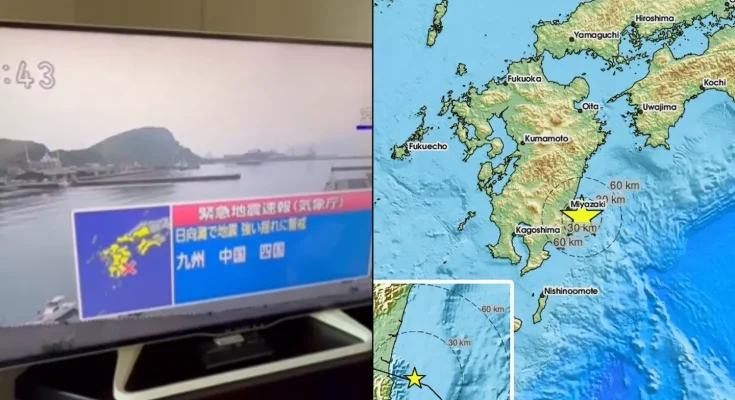Japan has been struck by a powerful earthquake, registering a magnitude of 7.1, which has triggered tsunami warnings along the country’s southern coast. The tremor has sent shockwaves through the region, prompting emergency responses and raising concerns about the potential for further seismic activity.
The Earthquake and Tsunami Warning

On August 8, 2024, at approximately 4:42 PM local time, a significant earthquake struck off the eastern coast of Japan’s southern main island of Kyushu, centered in the Hyuganada Sea region. Initially reported as a 6.9 magnitude earthquake, the Japan Meteorological Agency later revised the magnitude to 7.1.1 The earthquake occurred at a depth of about 18.6 miles (30 km), which is considered relatively shallow, making the tremors more strongly felt at the surface.
Following the quake, a tsunami advisory was issued, predicting waves up to 3 feet (1 meter) along the southern coast of Kyushu and the nearby island of Shikoku. The Japan Meteorological Agency urged residents in these areas to evacuate to higher ground and stay away from the coastline until the advisory is lifted.
Impact and Immediate Response

The earthquake caused significant shaking across the region, with videos circulating on social media showing buildings and shopping centers swaying under the force of the tremors. In Kirishima, Kyushu, local radio stations reported their studios shaking violently, with employees taking cover as the earthquake hit.
While the tsunami advisory was in place, the Japan Meteorological Agency reassured the public that the waves were expected to be minor. However, residents were still advised to take precautionary measures, given the unpredictable nature of aftershocks and potential secondary quakes.
The Megaquake Alert

In a rare move, Japan’s meteorological agency issued its first-ever alert for a possible “megaquake” just hours after the initial tremor. The agency stated that the chance of a major earthquake striking near the Nankai Trough, a notorious subduction zone, was higher than usual.2 This alert was based on the seismic activity detected near the trough, which could potentially lead to a magnitude 9.1 earthquake, similar to the catastrophic Tohoku earthquake in 2011.
Prime Minister Fumio Kishida, in response to the heightened risk, canceled a planned visit to Kazakhstan, citing the need to remain in Japan and address the growing concerns of the population. “People would be feeling anxious,” Kishida remarked, acknowledging the fear that grips the nation whenever seismic activity intensifies.
Historical Context and Seismic Activity

Japan, situated along the Pacific Ring of Fire, is one of the most seismically active countries in the world, experiencing an average of 1,500 earthquakes annually. The country has stringent building codes designed to withstand even the most powerful quakes, but the memories of past disasters, particularly the 2011 Tohoku earthquake and tsunami, remain vivid in the collective consciousness.3
The Nankai Trough, a 560-mile (900 km) subduction zone off Japan’s southwest coast, has been the site of several megaquakes over the centuries. The last significant quake in this region occurred in 1946, with a magnitude of 8.0, killing over 1,300 people. Experts have long warned that another massive earthquake could strike the region within the next few decades, potentially causing widespread devastation.
Ongoing Risk and Preparedness

While the immediate threat of a large tsunami has diminished, the risk of aftershocks and additional seismic events remains. The Japan Meteorological Agency has maintained its advisory for residents in the affected areas, urging them to stay vigilant and be prepared for further evacuation orders if necessary.
In the wake of this latest earthquake, Japan’s government has set up a special task force to monitor the situation and coordinate emergency responses. While there have been no reports of significant damage or casualties, the situation is being closely watched as aftershocks continue to rattle the region.
Conclusion

Japan’s recent earthquake and subsequent tsunami warning have once again highlighted the country’s vulnerability to natural disasters. As residents brace for potential aftershocks and the possibility of a megaquake, the nation remains on high alert. The swift response from the government and emergency services underscores Japan’s preparedness for such events, but the fear of what might come next lingers in the air.
Sources
- “Japan issues tsunami warning as 7.1 magnitude earthquake strikes country.” Lad Bible. Brenna Cooper. August 8, 2023
- “Japan issues first ever ‘megaquake’ warning after magnitude 7.1 tremor near Nankai Trough.” News. Dylan Donnelly. August 9, 2024.
- “Japan’s 7.1-magnitude earthquake sparks fresh concerns over looming megaquake.” Independent. Stuti Mishra. August 8, 2023



